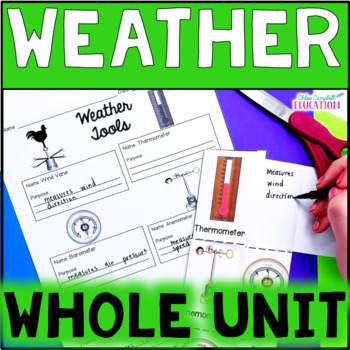It’s raining, it’s pouring, the standards call for a weather unit! So, you know you have to teach about the weather, but you don’t know where to start? Take your science curriculum into the stratosphere by including hands-on weather activities! When you start to dive in, there is a lot of information to cover about the weather. From cloud types to climate zones, weather tools to different kinds of precipitation, there’s so many topics to include. So what is the best way to teach all of these concepts? I am a firm believer in hands on activities when it comes to science, and weather is no exception. Here are 4 of my favorite ways to incorporate hands on weather activities into a unit.

Hands-on activities help students learn
I know my students love any opportunity to complete hands-on activities. Their engagement soars and that’s when I know they will be getting the most out of their learning. Hands-on activities keep kids engaged and having fun while they are learning or reviewing new concepts.

When my students have the opportunity to create or experiment with tangible items, I have found that they are more focused and willing to take the time they need to learn the concept.
Hands on activities are also a great opportunity to have students practice working collaboratively in groups. We all know how much our older students like to work in groups right?
These activities are sure to be a big hit in your classroom this year!
Types of precipitation
Teaching types of precipitation using a mobile, a foldable, and a game ensures that all your students, no matter their learning style, will be engaged and retaining the information.
Types of Precipitation Mobile
While creating a mobile is a fun and engaging activity loved by students, it’s also a great note taking activity too! The construction of the mobile ensures students are learning the vocabulary and definitions for the different types of precipitation.
For my older students I will use the set that requires students to write the definitions on the back of each of the cloud shaped mobile pieces. We do this together as a class to be sure everyone gets the same information.
I also have already completed options for younger students, those who need some differentiation, or for students who were absent when we completed the vocabulary and definitions as a class. This allows them to have the same information.
The students love putting this mobile together. Over the years I’ve noticed that by incorporating notes and vocabulary into engaging activities like this, students remember the information so much better.
Types of Precipitation Foldable
This is such an awesome activity because it really gets kids to take ownership of their learning. We all know how much smoother a lesson goes when kids feel like they have some voice and choice!
Before we even start folding paper, I challenge my students to come up with different hand signals for each type of precipitation. Sometimes, I put my students in groups and let each group collaborate to come up with a movement to represent their assigned type of precipitation.

It’s fun to watch students teaching the class how to use their hand signals to remember vocabulary. I’ve had some super clever gestures like shooting a basketball to represent hail jumping between clouds. My kids never cease to amaze me!
After our this, we make a quick foldable to review the main differences between the types of precipitation. Sometimes we work together as a class to fill in the information on the flaps, other times I partner people up to work collaboratively to fill in the information.
precipitation Game
Once the foldable is complete, I take a few minutes to introduce them to a game called “Don’t Say It!”. If you’ve ever played the game Taboo, you’ve already got the right idea. Students take turns trying to get their teammates to guess a vocabulary word. The trick is they have a list of words they can’t say while trying to give their teammates clues about the word. This is such a super fun game everyone will love!
Students are forced to really think through each vocabulary word as they describe it. It’s a great way to make sure they have a really deep understanding of the concepts and vocabulary.
Types of Clouds hands on weather activities
These cloud activities will help your students visualize and understand the differences between 4 types of clouds while providing them with engaging hands on learning.
Cloud Pop-up books hands on weather activities
Cloud pop-up books are a fun way for students to make a hands-on cloud study guide that is also interactive and engaging for everyone.
Using a template, the students are able to cut a special 3D shape in the paper creating a pop-up type card to attach a picture of a cloud to. Then, on the bottom part of the pop-up book, they can write the definition of each cloud type.
My students really love making these pop-up books. They get so excited about these books, that I tend to see them being created again and again outside of our weather unit.
Cloud mobile
Similar to the precipitation mobile, the cloud mobile is a fun hands-on activity to help students learn important vocabulary related to the different types of clouds. Students will create a mobile for the different types of clouds that includes a description of each.
This cloud mobile includes:
- Stratus
- Cumulus
- Cumulonimbus
- Cirrus
- Nimbostratus
- Stratocumulus
- Altostratus
- Altocumulus
While there are 8 different types of clouds included in the cloud mobile, you can choose which ones to include based on your teaching standards. Use all 8 or only include the ones your students are learning about. In Florida, students are required to know cirrus, stratus, cumulus, and cumulonimbus so those are the types I would focus on with my students.
Cloud type matching game and cloud characteristic chart
These activities are perfect for students to use as a review and assessment at the end of the cloud portion of your weather unit.
I like to start by giving my students time to play the cloud type matching game in small groups or with partners. Then, we can turn it into a whole class activity with a jeopardy style matching game between groups of students.
It’s such a fun way for my kiddos to review the information they have learned during the cloud portion of the unit.
As we wrap-up this topic, I use the cloud characteristic chart as an assessment tool. It’s a quick and easy way for me to identify how well students learned the information.
DIY Weather Instruments
Nothing will get your students more excited to learn about the weather than actually getting to track it themselves! One of my favorite ways to do this is to have students create their own weather instruments.
There are a lot of different weather instruments you can make with simple classroom and household materials. By teaching students about weather tools they get a glimpse into what a meteorologist might do behind the scenes before presenting the weather. Students learn that there’s more the daily weather forecast than just looking outside.
Speaking of a meteorologist, this is a great time in the unit to invite a local meteorologist to come and talk to the class. Students love learning about these tools used by scientists and then making their own.
I usually spend about 3 days making and testing our DIY Weather Tools. Over that time we create a barometer, anemometer, wind vane, thermometer and rain gauge. The students love digging into how each of these tools works. One of the favorite tools students will create is a rain gauge. Here’s a peek into what we do as we create this weather tool.
Rain Gauge
A homemade rain gauge is the perfect weather instrument to add to your weather unit! Students will get to practice taking and reporting on measurements. Plus, it can be so much fun to have students make predictions about how much rain will collect when a rainstorm is in the forecast!
Materials needed for a DIY rain gauge include:
- Two-liter bottle
- Scissors
- Masking tape
- Marker
- Measuring tape or ruler
- Some rocks
This is another great collaborative activity that your students can work on in small groups. It all really just depends on how many two-liter bottles you have. Everything else they need you probably already have on hand. With a little advance planning, you can ask your students and their families to save these bottles and send them in for your activity.
Once students are done creating their rain gauges, take a field trip outside and find a designated safe space for students to leave their gauges. Place the gauge outside and wait for it to rain!
Your students will be begging for it to rain so that they can see the results! This can be an ongoing task in your classroom with students rotating the responsibility of checking on the gauges daily or weekly to track the precipitation in your area.
Hands On Activities everyone will love!
Don’t let prepping for your weather unit, make you feel like you’ve survived a tornado! Be sure to grab the complete hands on weather activities Weather Unit which includes all of these activities and more. With 22 weather activities included in this bundle, you are sure to find engaging and fun hands-on weather activities you will be excited to use year after year! Watch your students transform into young meteorologists right before your eyes!
save these hands on weather activities
Save these hands on weather activities to your favorite science Pinterest board so you can quickly come back the next time you need to add some engaging, hands on weather activities to your lesson plans.










Leave a Reply